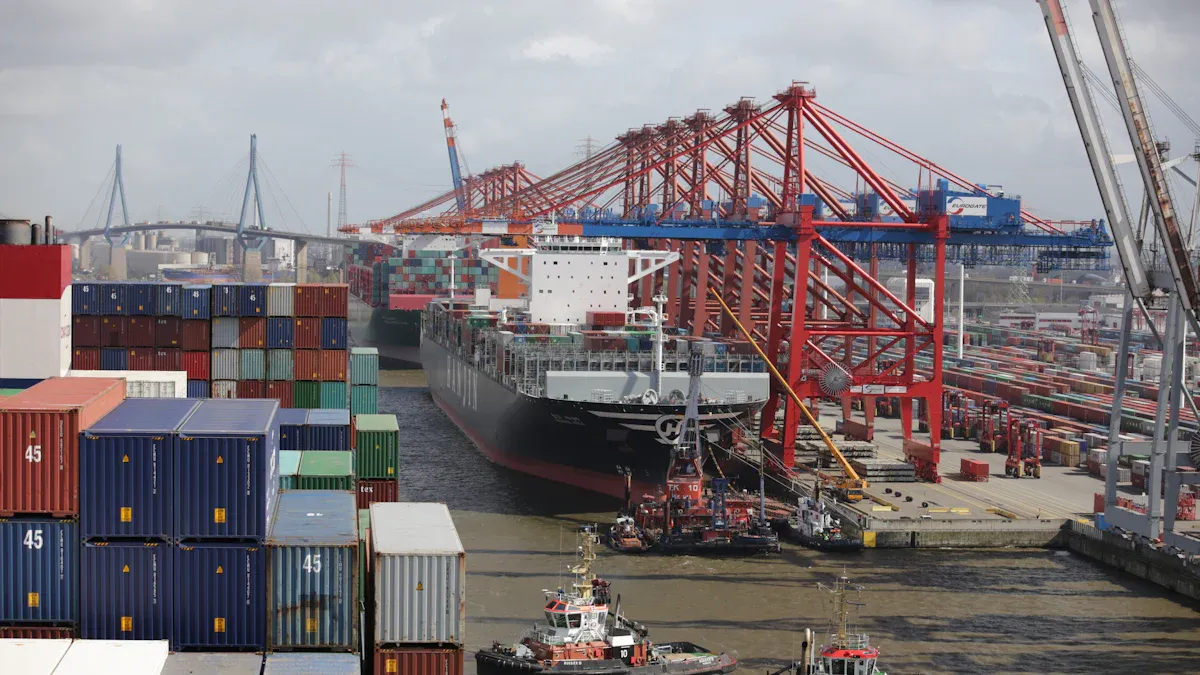The Best Shipping Methods for Bulk Purchasing Products from China

When importing bulk purchasing products from China, choosing the right shipping method is crucial. Sea freight offers the lowest cost for large shipments, while air freight ensures faster delivery. Rail freight balances cost and speed, making it ideal for certain goods. Express shipping provides the quickest option for urgent, smaller deliveries.
Key Takeaways
Shipping by sea is the cheapest for big shipments. It works best for buying in bulk.
Shipping by air is the fastest for urgent packages. It ensures quick delivery for expensive items.
Express shipping is fast and affordable. It’s good for small, urgent deliveries.
Overview of the Shipping Process for Bulk Purchasing Products
Key Stages in the Shipping Process
When importing bulk purchasing products from China, understanding the shipping process is essential. Each stage plays a critical role in ensuring your goods arrive safely and on time.
Getting goods delivered to the port of departure: Your supplier prepares the shipment and transports it to the designated port.
Clearing goods for export: Customs officials review the necessary documents, such as the commercial invoice and packing list, to approve the shipment for export.
Shipping goods to the destination: Depending on your chosen shipping method, the goods are transported via sea, air, rail, or express services.
Clearing goods for import and final delivery: Once the shipment reaches your country, customs clearance is required before the goods are delivered to your local warehouse or distribution center.
Proper documentation is vital at every stage. Key documents include the commercial invoice, which lists the goods and their prices, the packing list detailing shipment contents, and the bill of lading, which serves as a contract for the shipment.
Common Challenges in Shipping from China
Shipping bulk orders from China can present several challenges. Tariffs and duties often complicate cost calculations, making it crucial to understand these fees upfront. Delays caused by weather or customs inspections can disrupt your supply chain. Additionally, improper packaging increases the risk of product damage during transit.
Lost shipments are another concern. To mitigate this, choose reliable logistics providers that offer tracking and insurance options. Effective communication with suppliers, freight forwarders, and customs agents is also essential to avoid misunderstandings. Language barriers may arise, so professional translation services can help ensure clarity.
By addressing these challenges proactively, you can streamline your shipping process and minimize potential disruptions.
Comparing Shipping Methods from China

Sea Freight: Cost-Effective for Large Volumes
Sea freight remains the most economical option for transporting bulk purchasing products. It offers two flexible methods: Full Container Load (FCL) and Less than Container Load (LCL).
FCL: Ideal for large shipments, costing between $1000 and $5000 per container. It ensures security and cost-efficiency for high-volume goods.
LCL: Suitable for smaller shipments, priced at $30 to $40 per cubic meter. It combines your goods with others, reducing costs.
Sea shipping from China is particularly advantageous for heavy or oversized goods that air freight cannot accommodate. The cost per unit decreases as shipment size increases, making it highly cost-effective. However, delivery times vary. For example, shipping from Shenzhen to Los Angeles takes about 15 days, while routes to Miami can take up to 38 days.
Sea Freight Route | Estimated Delivery Time |
|---|---|
Shenzhen to Los Angeles | 15 days |
Shenzhen to Miami | 38 days |
Shenzhen to New York | 28 days |
Air Freight: Fastest Option for Urgent Shipments
Air freight from China is the fastest shipping method for time-sensitive deliveries. Transit times typically range from 3 to 7 days, with express options delivering within 24 to 72 hours. Airlines adhere to strict schedules, ensuring reliability and predictability.
Minimal handling reduces the risk of damage.
Time-critical shipments benefit from rapid delivery.
Ideal for high-value or perishable goods.
While air freight is more expensive than sea shipping, its speed justifies the cost for urgent needs. Costs depend on weight, dimensions, and destination. For example, terminal handling charges and security fees may apply, increasing overall expenses.
Express Shipping: Balancing Speed and Convenience
Express shipping from China offers a balance between speed and convenience. It is faster than sea freight and more affordable than air freight for smaller shipments. Delivery times vary by provider:
FedEx International Priority: 1-3 business days.
DHL Express Worldwide: 2-4 business days.
China Post EMS: 3-7 business days.
Express shipping is ideal for businesses requiring quick delivery without the high costs of air freight. It also provides door-to-door service, simplifying logistics for smaller shipments.
Rail Freight: A Middle Ground for Cost and Time
Rail freight bridges the gap between sea and air freight. It is faster than sea freight, with transit times of 12 to 18 days, and cheaper than air freight. Improved infrastructure has made rail freight increasingly popular for shipments to Europe.
Advantage | Rail Freight |
|---|---|
Cost | Cheaper than air freight |
Speed | Faster than sea freight |
Transit Time | Typically 12-18 days |
Rail freight is a reliable option for medium-priority shipments. It offers a cost-effective solution for businesses seeking a balance between speed and affordability.
Last-Mile Delivery and Its Impact on Shipping Cost

Local Delivery Services for Bulk Orders
Last-mile delivery plays a critical role in the overall shipping process. It refers to the final step of transporting goods from a distribution center to their destination. For bulk orders from China, this stage often becomes the most challenging and expensive. The high shipping cost arises from the complexities of reaching individual customers, especially in areas with limited infrastructure. Inefficiencies in logistics operations, such as multiple stops and smaller delivery loads, further contribute to these expenses.
To optimize last-mile delivery, you can partner with local delivery services that specialize in handling bulk shipments. These providers often have established networks and expertise in navigating local routes, ensuring timely and efficient delivery. Additionally, leveraging technology like route optimization software can help reduce delays and minimize costs. By streamlining this stage, you can enhance customer satisfaction while keeping expenses under control.
Warehousing and Distribution Solutions
Effective warehousing and distribution solutions are essential for managing bulk shipments from China. These solutions not only improve efficiency but also reduce the overall shipping cost. Key processes include:
Receiving: Goods are inspected and logged into the system upon arrival.
Storage: Items are organized systematically for easy access.
Dispatch: Products are picked and loaded for delivery.
Inventory control: Stock levels are monitored to prevent shortages or overstocking.
Strategically located warehouses can further enhance your supply chain. They provide quicker access to production, simplify domestic and international shipping, and lower import duties through Free Trade Zones. Additionally, these facilities support better inventory management and offer value-added services like packaging and labeling. By investing in robust warehousing and distribution systems, you can streamline operations and meet market demands efficiently.
Key Factors to Consider When Choosing Shipping Methods
Shipping Cost and Budget Constraints
Shipping cost plays a significant role in determining the best shipping methods from China. You must evaluate your budget and consider the cost-effectiveness of each option. Sea freight is the most economical for large shipments, while air freight is more expensive but faster. Express shipping offers convenience for smaller orders but comes at a premium. Rail freight provides a middle ground, balancing cost and delivery time.
To optimize costs, compare quotes from multiple freight forwarders. Look for hidden fees, such as terminal handling charges or customs duties, which can inflate the total shipping cost. Partnering with reliable logistics providers ensures transparency and helps you stay within budget.
Shipping Time and Delivery Deadlines
Shipping time is critical when meeting delivery deadlines. Ocean freight typically takes 30 to 40 days, making it unsuitable for urgent shipments. Air freight delivers within 3 to 7 days, while express shipping can reduce this to 1 to 3 days. Rail freight offers a compromise, with transit times of 12 to 18 days.
Several factors influence delivery schedules:
Festivals in China, like Chinese New Year, can disrupt shipping timelines.
Port congestion and customs inspections often cause delays.
Weather conditions impact ocean freight more than air freight.
Planning shipments around these variables ensures timely delivery.
Type and Volume of Goods Being Shipped
The type and volume of goods determine the most suitable shipping solutions. For instance:
Recommended Use Case | Restricted Types of Goods | |
|---|---|---|
Sea shipping | Large or heavy goods, bulk amounts | Flammable, hazardous goods |
Air freight | Small, light, valuable goods | Strong magnets, lithium batteries |
Express | Small urgent orders | Strong magnets, lithium batteries |
Rail freight | Large, heavy products, bulk orders | Dangerous products like toxins |
Choose a method that aligns with your product specifications to avoid complications.
Customs and Destination Requirements
Customs regulations significantly impact shipping. You must comply with safety and quality standards, such as the Consumer Product Safety Improvement Act (CPSIA) and FDA regulations. Proper labeling, including Country of Origin and warning labels, is mandatory.
Essential documents include:
Commercial Invoice: Describes goods, quantity, and value.
Bill of Lading: Provides shipping details.
Packing List: Details package contents.
Entry Summary: Summarizes goods for customs.
Customs bonds, whether single-entry or continuous, ensure duties and taxes are paid. Adhering to these requirements prevents delays and ensures smooth delivery.
Recommendations for Bulk Purchasing Products
Best Shipping Methods for Large, Heavy Shipments
When handling large or heavy shipments from China, selecting the right shipping method ensures cost-efficiency and timely delivery. The following table outlines the best options for such shipments:
Shipping Method | Description |
|---|---|
Express Door-to-door Shipping | Fastest option for urgent deliveries. |
DHL | Offers heavy shipping options for international and expedited shipping. |
UPS | Provides various services, including overnight delivery. |
FedEx | Offers heavy and oversized shipping services, including Ground and Freight options. |
Air freight combined with express | Sends urgent air freight to the destination airport, then delivered by express service. |
Ocean freight combined with express | Carries international shipments via ocean carriers, with options for Less Than Container and Full Container. |
For large shipments, sea shipping from China remains the most economical option. Combining ocean freight with express delivery can further optimize costs while ensuring timely last-mile delivery.
Best Shipping Methods for Time-Sensitive Deliveries
Time-sensitive deliveries require fast and reliable shipping solutions. The following methods are ideal for meeting tight deadlines:
Express Shipping: The fastest method, with transit times of 5 to 7 working days. It is perfect for high-value or urgent products.
Air Freight: A reliable option for perishable goods and sensitive items. Transit times range from 2 to 20 days, depending on the route.
Tip: Express shipping reduces the risk of damage and guarantees delivery time, but it is the most expensive option. Consider air freight for a balance between speed and cost.
Balancing Shipping Cost and Efficiency
Balancing shipping cost and efficiency requires a strategic approach. Follow these steps to optimize your shipping process:
Use air freight for smaller shipments or time-sensitive goods, despite higher costs.
Choose rail freight for a cost-effective alternative to air freight, with transit times of 12 to 18 days.
Opt for sea freight for larger shipments, which typically take four to five weeks but offer the lowest cost per unit.
Selecting the right ports also impacts cost and delivery time. Ports like Shanghai, Shenzhen, and Ningbo in China, and Los Angeles and New York in the US, handle large volumes of cargo efficiently. However, avoid peak seasons to minimize delays and additional fees.
Note: Factors like weight, volume, and customs duties influence shipping costs. Understanding these variables helps you make informed decisions.
Choosing the right shipping methods from China is essential for managing shipping cost, shipping time, and delivery efficiency. For bulk purchasing products, sea freight offers cost-effective solutions for large shipments, while air freight ensures quick delivery for urgent needs. Express shipping works best for small, time-sensitive deliveries.
To align shipping methods with your business priorities, consider factors like product type, urgency, and budget. For instance, air freight suits high-value goods requiring fast delivery, while sea freight is ideal for non-urgent bulk shipments. Understanding these factors helps you optimize shipping strategies and meet your delivery goals effectively.
Tip: Evaluate shipping capacity, customs requirements, and delivery deadlines to ensure smooth operations and avoid delays.
FAQ
What is the cheapest way to ship bulk products from China?
Sea freight offers the most cost-effective solution for bulk shipments. It is ideal for large volumes and heavy goods, significantly reducing your shipping expenses.
How long does it take to ship goods from China to the US?
Shipping times vary by method. Sea freight takes 15-40 days, air freight 3-7 days, and express shipping delivers within 1-3 days.
Can you track shipments from China?
Yes, most logistics providers offer tracking services. You can monitor your shipment's progress through tracking numbers provided by your freight forwarder or courier.
See Also
Top Suppliers for Bulk Flashlights at Wholesale Prices
Comprehensive Guide to Purchasing Bulk Wholesale Flashlights
Key Tips for Sourcing Bulk Flashlights from China
Selecting Ideal LED Flashlights for Bulk Buying
Finding Budget-Friendly Wholesale Flashlights for Bulk Orders
About US
Follow Us
Hello,Friend,
I am Mary from Helius, we are manufacturer of LED lighting products with more than a decade of experiences.
We offer hot selling products in market and guarantee the quality with competitive cost.
Let’s have more discussion on your inquiry.
Or you can reach out me via what’s up/tele gram +8618123952945 if it’s favorable to you.
Address
4th Floor, Building A16, Intelligent terminal industrial park of Silicon Valley, Dafu Industrial Zone,Guanlan, Shenzhen, 518110 China
Contacts
mary@heliuslights.com
heliuslight04@hotmail.com
+0086 18123952945
